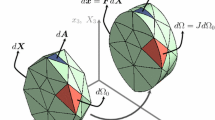Abstract
A symbolic procedure is utilized to derive the analytical expressions of the component matrices resulting to the closed-form integration of a stiffness matrix of a hybrid finite element. In order to alleviate the expression growth problem, we employ special techniques, including the use of symmetry conditions, pattern search, and introduction of intermediate variables, so that the final form of the derived stiffness matrix is suitable for coding implementation. Application of the symbolic procedure is made on a hybrid three-dimensional 8-node solid element. The same procedure is equally applicable to other types of hybrid elements.
Similar content being viewed by others
References
MACSYMA Reference Manual (1984) Version 10. The MATHLAB Group, Laboratory for Computer Science, MIT
Gunderson, R.H.; Cetiner, A. (1971) Element stiffness matrix generator. J. Struct. Div., ASCE 97, 363–375
Luft, W.; Roesset, J.M.; Conner, J.J. (1971) Automatic generation of finite element matrices. J. Struct. Div., ASCE 97, 349–362
Jos, R.G. (1972) Generalization of plate finite elements to shells. J. Eng. Mech. Div., ASCE 98, 385–400, April
Anderson, C.M.; Noor, A.K. (1975) A Computerized Symbolic Integration Technique for Development of Triangular and Quadrilateral Composite Shallow-Shell Finite Elements.” NASA TN D-8067
Peterson, P. (1977) On computer-aided analytic element analysis and the similarities of tetrahedron elements. Int. J. Numer. Meth. Eng. 11, 611–622
Cecchi, M.M.; Lami, C. (1977) Automatic generation of stiffness matrices for finite element analysis. Int. J. Num. Meth. Eng. 11, 396–400
Noor, A.K.; Andersen, C.M. (1977) Computerized symbolic manipulation in structural mechanics-progress and potential. Comput. Struct. 10, 95–118
Noor, A.K.; Andersen, C.M. (1977) Mixed isoparametric finite element models of laminated composite shells. Comput. Meth. Appl. Mech. Eng. 11, 255–280
Anderson, C.M. (1978) Evaluation of integrals for a ten-node isoparametric tetrahedral finite element. Comput. Meth. Appl. Eng. 5, 297–320
Noor, A.K.; Andersen, C.M. (1981) Computerized symbolic manipulation in nonlinear finite element analysis. Comput. Struct. 1, 9–40
Korncoff, A.R.; Fenves, S.J. (1979) Symbolic generation of finite element stiffness matrices. Comput. Struct. 10, 119–124
Wang, P.S.; Chang, T.Y.P.; Van Hulzer, J.A. (1984) Code generation and optimization for finite element analysis (Eds. G. Goos; J. Hartmanis). EUROSAM 84 Conference Proceedings, New York: Springer-Verlag, LNCS Series, July
Chang, T.Y.P.; Saleeb, A.F.; Wang, P.S.; Tan, H.Q. (1986) On the symbolic manipulation and code generation for elasto-plastic material matrices. Eng. Comput. 1, 205–215
Wang, P.S.; Tan, H.Q.; Chang, T.Y.P.; Saleeb, A.F. (1986) The code generation for hybrid-mixed mode formulation in finite element analysis. ACM SYMSAC-86 Proceedings, Waterloo, Canada
Wang, P.S. (1986) FINGER: A symbolic system for automatic generation of numerical programs in finite element analysis. J. Symbol. Comput. 2, 305–316
Tan, H.Q. (1989) Symbolic derivation of equations for mixed formulation in finite element analysis. Comput. Math. E. Kaltofen (ed.), Springer-Verlag New York, 289–298
Tan, H.Q. (1989) Integration of symbolic and numerical computations in finite element analysis. In: IMACS Transactions on Scientific Computing, Vol. 1.2: Numerical and Applied Mathematics. Basel, Switzerland: J.C. Baltzer AG, Scientific Publishing Co. 641–645
Chang, T.Y.P.; Tan, H.Q.; Zheng, D.; Yuan, M.W. (1990) Application of symbolic method to hybrid/mixed finite elements and computer implementation. Comput. Struct. 35:4, 293–299
Pian, T.H.H. (1964) Derivation of element stiffness matrices by assumed stress distribution. AIAA J. 2, 1333–1336
Pian, T.H.H. Cheng, D.P.; Kang, D., (1983) A new formulation of hybrid/mixed finite element. Comput. Struct. 16, 81–87
Pian, T.H.H. (1985) Finite element methods based on consistently assumed stresses and displacements. Finite Elem. Analy. Des. 1, 131–140
Spilker, R.L. (1982) Invariant 8-node hybrid stress elements for thin and moderately thick plates. Intro. J. Num. Meth. Eng. 18, 1153–1178
Pian, T.H.H.; Kang, D.; Wang, C. (1986) Hybrid plate elements based on balanced stresses and displacements. In: State-of-the-Art on Finite Element Methods in Plate and Shell Structures, Vol. 1, Element Technology (Eds. T.J.R. Hughes; E. Hinton). Swansea, UK: Pineridge Press International, pp. 244–265
Lee, S.W.; Dai, C.C.; Yeom, C.H. (1985) A triangular finite element for thin plates and shells. Int. J. Num. Meth. Eng. 21, 1813–1831
Saleeb, A.F.; Chang, T.Y.P.; Graf, W. (1987) A quadrilateral shell element using a mixed formulation. Comput. Struct. 26, 787–803
Kang, D.S.; Pian, T.H.H. (1988) A 20-DOF hybrid stress general shell element. Comput. Struct. 30, 789–794
Tong, P. (1969) An assumed stress hybrid finite element method for an incompressible and near-incompressible material. Int. J. Solids Struct. 5, 455–461
Pian, T.H.H.; Tong, P. (1986) Relations between incompatible displacement model and hybrid stress model. Int. J. Num. Meth. Eng. 22, 173–181
Pian, T.H.H.; Wu, C.C. (1988) A rational approach for choosing stress terms for hybrid finite element formulations. Int. J. Num. Meth. Eng. 26, 2331–2343
Hughes, T.J.R. (1978) The Finite Element Method. Englewood Cliffs, NJ: Prentice-Hall
Chang, T.Y.P. (1988) NFAP—A general purpose nonlinear finite element analysis program for static and dynamic loadings. User Manual, Department of Civil Engineering, University of Akron, Akron, OH, October 1
Belytschko, T.; Liu, W.K.; Ong, J.S.-J.; Lam, D. (1985) Implementation and application of a 9-node lagrange shell element with spurious mode control. Comput. Struct. 20, 121–128
Stanley, G.M.; Park, K.C.; Hughes, T.J.R. (1986) Continuum-based resultant shell elements. In:Finite Element Methods for Plate and Shell Structures, Vol. 1: Element Technology (Ed. T.J.R. Hughes, E. Hinton). Swansea, UK: Pineridge Press International, pp. 1–45
Author information
Authors and Affiliations
Rights and permissions
About this article
Cite this article
Tan, H.Q., Chang, T.Y.P. & Zheng, D. On symbolic manipulation and code generation of a hybrid three-dimensional solid element. Engineering with Computers 7, 47–59 (1991). https://doi.org/10.1007/BF01208345
Issue Date:
DOI: https://doi.org/10.1007/BF01208345




